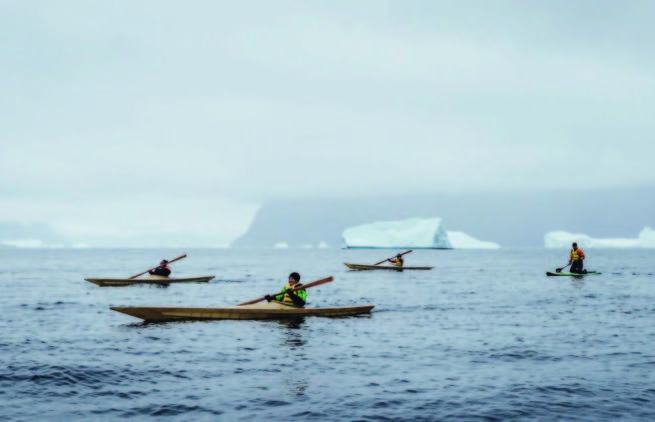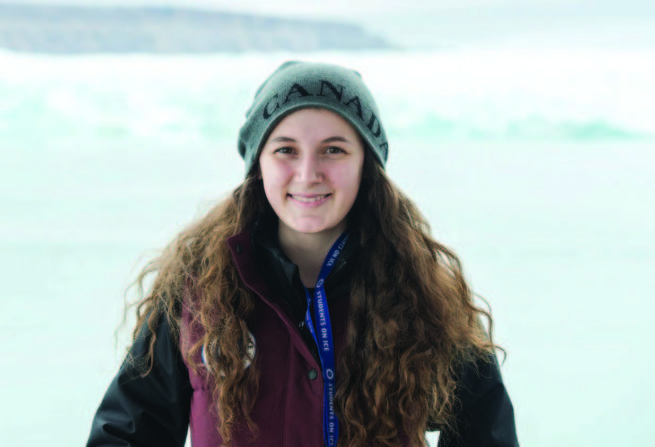January 1, 2017
An Edmonton student embarks on an Arctic expedition to learn about the challenges facing Canada’s most misunderstood region
WHITE PEAKS of ice rose above Cassandra Pryer’s head as she walked over Arctic dirt packed into the creases and crevasses of the massive glacier in Croker Bay on Devon Island, Nunavut. As she
walked with other students from around the world, they learned about the glacier from a biologist, and they saw the effects of climate change first-hand, drinking from a stream that may not freeze again due to gradually increasing temperatures.
It was just day four of a 16-day trip where 120 students and 80 staff from around the world — with 17 countries represented — sailed through the Canadian high Arctic and a western part of Greenland. The program is called Students on Ice and it provides students first-hand knowledge of the Arctic from scientific, cultural, historical, and artistic points of view.
They travelled aboard the MS Ocean Endeavour, a 450-foot ship with nine decks and plenty of room for educational spaces including an art studio and a science lab, where students learned from experts about all aspects of life in the Arctic. There were about 80 staff members on board, including biologists, paleobiologists, historians, artists, naturalists, Inuit elders, human rights advocates, politicians, musicians and mental health advocates sharing their knowledge.
“There was always something new to learn, and in a way the subjects are all connected. The artist is trying to get the message out about climate change, so they need the scientist. And the scientist needs the artist to get the message out,” says Pryer.
And the Arctic is the ideal place to learn about interconnection, says expedition manager of Students on Ice, Shirley Manh, as what happens here affects the rest of the world. “What happens in the poles does not stay in the poles. It actually affects everything else. It affects the health of our oceans, sea levels. Climate change in the rest of the world is directly linked to climate change in the Arctic, so it’s a very interconnected system,” says Manh.

Workshops were held on the ship and on land, where students also had the opportunity to visit northern communities. The trip started in Ottawa before students boarded their vessel in Resolute Bay, Nunavut — they travelled through migratory bird sanctuaries, visited residents in Pond Inlet, were joined by Inuit elders in Sirmilik National Park, hiked in Baffin island, and stopped in various communities in Greenland. Meanwhile, onboard, students studied a huge array of topics including: Inuit culture and clothing, mining in the Arctic, climate change, seal skinning, dealing with mental health issues, film production and art.
The ship carried 20 Zodiacs, which are inflatable boats that took the students to land and on portable workshops where they could learn about wildlife and the ecology of parts of the area — like that of the Devon Island glacier — up-close and first-hand.
Pryer first learned about Students on Ice as a volunteer on the youth advisory committee for Young Edmonton Grants (YEG), an Edmonton Community Foundation (ECF) program that provides young people with funds to participate in projects and initiatives of all kinds. Members of the committee were given a chance to apply and the science aspect of the program particularly drew her interest. The cost of the trip is high — $12,000 — but eighty per cent of the students are able to take part due to scholarships like the one provided by ECF.
For many of the students, it’s an opportunity they normally wouldn’t have, says Kary Laplante, a guidance counsellor and grad coach at Archbishop MacDonald Catholic High School, where Pryer’s in the twelfth grade. At the school, students come from a wide range of financial situations, and a trip that costs more than a used car would not even make it past many parents’ radars. Pryer admits that without the scholarship, the trip would not have been an option for her either. Giving students of all kinds a chance to learn and see first-hand a unique part of the world has far-reaching effects.
Manh can attest to the impact of the trip as she attends each one and sees students interacting with experts. She recalls seeing oceanographers take students on a Zodiac, where they collect phytoplankton, which are photosynthesizing microscopic organisms, and learn about the invisible life in the water. The samples are then taken back to the ship and examined through a microscope. “I’ve seen a student who has never demonstrated an interest in science class before; and now, all of a sudden, all he wants to do is spend his time looking at the invisible life that he’s
helped pull from the ocean,” says Manh.
For Pryer, the science aspect of the program was what originally drew her interest, but as she participated in the workshops, she began to grasp the importance of many other topics including the history of the Arctic, and the impacts of residential schools along with intergenerational trauma that still occurs. These are topics, she says, she had not learned about in school — and now, she was hearing about them first-hand from Inuit elders, making the impact all the more powerful.
During the trip, Inuit elders taught students about building a kayak and the intricate work of using sealskin in its production. The kayaks are used for seal hunting and if even a single hair is left
on the skin, it could jeopardize a hunt by causing a ripple heard by seals in the water. Pryer travelled via these kayaks around glaciers in Greenland, while learning about the colourful buildings within the community, each shade signifying a different type of building, whether a hospital or school or community hall.

Pryer unpacks memories as though they’re the souvenirs of her trip — the time a seal came right up to the Zodiac, the experience of eating whale skin for the first time, hiking to a waterfall and eating berries along the tundra, taking part in an archaeological dig, and seeing remnants of the Franklin expedition.
She learned from experts, but also from the other students on board; there were students who already called the Arctic home, and others who lived as far away as Monaco. Through the students she learned about places all around the world — a student from Malaysia taught her some traditional games and others talked about the social and economic conditions in their own countries.
“It was interesting to put faces to places on the map now. Now, there are people I know all over the world,” says Pryer, who’s also excited to come home and share her experiences with students at her school.
She plans to speak of her experience with Students on Ice through a program at Archbishop MacDonald called Personal Learning Time. Guidance counsellor Laplante says the presentation will inevitably inspire others. “We’re an academic school so we have students come from all over Edmonton. And I think some of them are quite sheltered. They study, they go home, they’re in this box, and they go on the Internet. I think to see that she was able to apply to this program, and learn about issues within the world happening right now — it’s inspiring. And it’ll encourage them to step out of that box,” says Laplante.
Pryer went into the program knowing she will likely pursue a career in the sciences, but the knowledge she’s gained has opened up all kinds of possibilities she hadn’t considered. She’s developed an interest in marine biology after studying animals and organisms on the boat; she has an appreciation for Arctic history and Inuit culture; and she sees possibilities for combining the arts with
the sciences in unique ways.
One of Manh’s favourite parts of her job is seeing how the new experiences can make an impact — parents tell her their children are now excited to learn about subjects that never held their interest in the past. The trip can improve not only a student’s educational experience; it can change the course of their lives. “At this particular point in their lives, they are so open to opportunity; they are open to change without knowing it and that is the beauty of travelling with young people. There’s so much potential. They don’t know what they will do in a couple of months, never mind later in their careers,” says Manh.